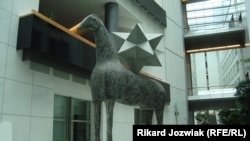Of all the European Union institutions in Brussels, the European Parliament is probably the one building worth visiting, perhaps not to listen to the endless committee discussions that take place when the members of the parliament aren't busy traveling back and forth between the Belgian capital and the parliament's other site, Strasbourg.
It's worth visiting for the sheer quirkiness of the place.
To start with there is the artwork, some of which has been donated as gifts from national parliaments while other pieces are paid for by the chambers' budget -- a sum that is far from completely transparent. Estonia provided the building with a nice piano that no one is allowed to play on, at least not during working hours.
Denmark's contribution, which hung next to one of the cafeterias, was removed with no apparent explanation, though its resemblance to a very private female body part might have had something to do with it.
The Italian art, however, is likely to stay, not because of its exquisite beauty but more because it will prove extremely difficult to get rid of a 6-meter-high metal horse placed in the middle of a hallway. It's not too hard to guess which Italian prime minister it is nicknamed after.
To top it all of there is the "Tree of Integration," consisting of various connected iron bars that creep along a six-story staircase. Every August, a cleaner has to be elevated along the whole construction equipped with a feather duster to give it a rub down. It's a job that takes at least a week.
And then you have the buildings themselves. It is somewhat strange that the far-left party group shares the same corridors as the Christian Democrats but it is a wonderful irony that the Euroskeptics and the far-right MEPs are housed in a building named after the former German Chancellor Willy Brandt -- a Social Democrat and committed European.
The most quirky thing, however, is the fact that the large complex of connected buildings straddles two Brussels municipalities, meaning that various parts of the place have different postcodes. It also means that the passage connecting two of the main buildings at the crossing of the municipal border is probably a tax-free zone since, technically speaking, it hasn't got an address. No one has pitched a tent there yet, but one wouldn't be surprised if it happened sometime soon.
-- Rikard Jozwiak
It's worth visiting for the sheer quirkiness of the place.
To start with there is the artwork, some of which has been donated as gifts from national parliaments while other pieces are paid for by the chambers' budget -- a sum that is far from completely transparent. Estonia provided the building with a nice piano that no one is allowed to play on, at least not during working hours.
Denmark's contribution, which hung next to one of the cafeterias, was removed with no apparent explanation, though its resemblance to a very private female body part might have had something to do with it.
The Italian art, however, is likely to stay, not because of its exquisite beauty but more because it will prove extremely difficult to get rid of a 6-meter-high metal horse placed in the middle of a hallway. It's not too hard to guess which Italian prime minister it is nicknamed after.
To top it all of there is the "Tree of Integration," consisting of various connected iron bars that creep along a six-story staircase. Every August, a cleaner has to be elevated along the whole construction equipped with a feather duster to give it a rub down. It's a job that takes at least a week.
And then you have the buildings themselves. It is somewhat strange that the far-left party group shares the same corridors as the Christian Democrats but it is a wonderful irony that the Euroskeptics and the far-right MEPs are housed in a building named after the former German Chancellor Willy Brandt -- a Social Democrat and committed European.
The most quirky thing, however, is the fact that the large complex of connected buildings straddles two Brussels municipalities, meaning that various parts of the place have different postcodes. It also means that the passage connecting two of the main buildings at the crossing of the municipal border is probably a tax-free zone since, technically speaking, it hasn't got an address. No one has pitched a tent there yet, but one wouldn't be surprised if it happened sometime soon.
-- Rikard Jozwiak
